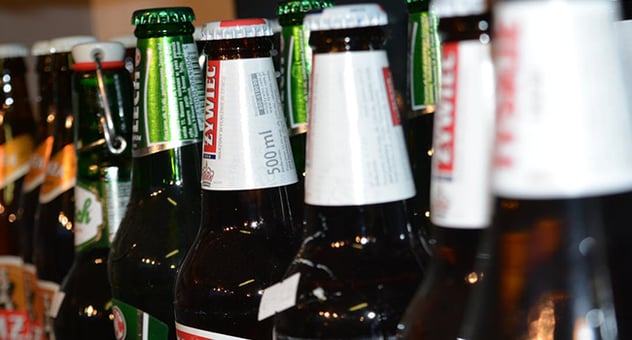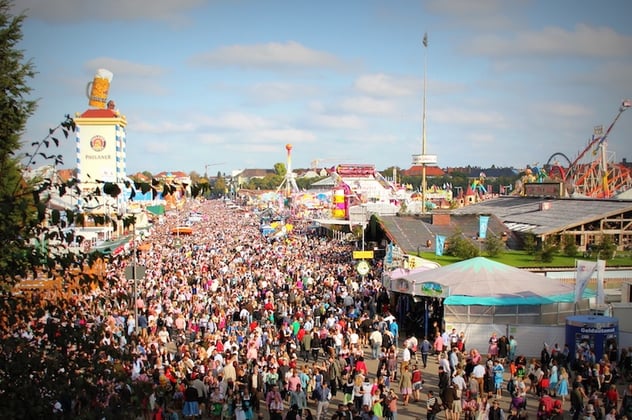While much has changed throughout humanity’s long history, one thing has remained the same for millennia: our love of beer. Humans have been brewing beer longer than we’ve been baking bread!
Beer is thought to have originated in Ancient Sumer and most likely reached Europe sometime late in the Bronze Age, with brewing beginning in Germany. It’s no surprise that Germans were probably the first to brew in Europe, given the prominence of beer in German culture.
German beers – a quick overview
Germany ranks third in the world for beer consumption. The country produces over 5000 styles of beer in its 1400 breweries, amounting to 95.8 million hectolitres of beer annually.
Germany is home of the largest beer festival in the world (Oktoberfest) and the creator of the Beer Purity Law (Reinheitsgebot), which after 500 years is still in effect.
In the Middle Ages, beer brewing changed from a domestic activity to a commercial enterprise. This change was largely thanks to German monks who introduced hops to the brewing process, improving the taste and quality of beer while acting as a natural preservative.
Additionally, Germans improved the equipment used in the process, which allowed for more frequent brewing on a larger scale, leading to skyrocketing beer consumption.
Watch the German Beer course on Typsy.com

The Reinheitsgebot – Germany’s Beer Purity Law
In 1516, the Reinheitsgebot (Beer Purity Law) was adopted in Bavaria. This centuries-old set of regulations is still in effect today, though slightly modernized.
The Reinheitsgebot stated that the only ingredients allowed for beer brewing were water, barley and hops. Yeast was later added once its important role in the brewing process was realized.
There were a number of reasons for the implementation of the Beer Purity Law but two are perhaps most important. The first was about beer quality. By specifying the three allowed ingredients, the law banned nasty additives. The second was about grain price competition. Because bread couldn’t be made with barley, the exclusive use of it for beer stopped the prices of wheat and rye from escalating.
By the mid-1500s, the law was loosened to allow for the use of other ingredients, such as wheat and coriander, allowing for the thriving wheat beer industry in Germany.

While many regional brewing traditions were sadly lost as a result of this law (notably spiced and cherry beer), some survived and continue to be popular today including the Kölsch, Gose and Altbier.
In 2005, German courts decided that the brewing and sale of beer which did not follow the Reinheitsgebot would be allowed – as long as it was not called beer.
Beers brewed according to Reinheitsgebot are regarded as beers of the highest quality. As only four ingredients are used, the brewing process requires great skill and creativity. It plays a powerful marketing tool today.
With the craft beer market on the rise in Germany, many are ditching the Reinheitsgebot due to the limitations it places on brewers who want to experiment with many natural ingredients.
Oktoberfest – The world’s largest beer festival
This year will mark 185 years of Oktoberfest celebrations. Oktoberfest is the largest beer festival in the world, held annually in Munich where millions converge to celebrate German beer. In many cities across the globe, festivities modelled on Munich’s Oktoberfest are also held annually.
Only six breweries create the beers available at Oktoberfest: Spaten, Löwenbräu, Augustiner-Bräu, Hofbräu-München, Paulaner and Hacker-Pschorr. This is because all beer sold at Oktoberfest must be brewed in Munich and in accordance with the Reinheitsgebot.

Popular German beer styles
Given that Germany produces over 5000 styles of beer, no one expects servers and bartenders to be well-versed on each one. But there are some stand-out favorites you should become familiar with.
Pilsner
The pilsner style is the most popular in Germany, with a market share of about 60%. Interestingly, the pilsner style was created back in 1842 in modern-day Czech Republic. It is named after the city where it originated.
The pilsner style is hugely popular worldwide. This is an easy-drinking, refreshing, golden-colored lager which pairs well with most foods. The German pilsner is less bitter, has a lighter color and a bit more body than its Czech counterpart.
Bock
Bock is a strong lager brewed in many different styles, such as the doppelbock (the stronger version, almost black in color), maibock (also known as helles, it is the paler and hoppier version) and eisbock (the very dark, very heavy version which is made by freezing water out of beer, resulting in a much boozier drink).
Bocks are malty and toasty in aroma and flavor but still have that lager crispness. Legend has it that German monks survived long periods of fasting by drinking bock! While a pint of bock can feel like a meal in itself, it pairs very well with meat and other hearty foods.
Weissbier
Wheat beer is brewed with a larger portion (at least 50%) of wheat than barley, resulting in a fruity aroma and flavor, with prominent banana and clove notes. In Belgium and the Netherlands, it is known as witbier. German law dictates that wheat beers must be top-fermented, meaning wheat beers are all ales.
Hefeweizen are unfiltered, while Kristallweizen are filtered. Dark (Dunkelweizen) and strong (Weizenbock) wheat beers are also brewed.
Berliner Weisse is a sour wheat beer which is low in alcohol and unique in flavor.
Gose is a wheat beer famous for the addition of coriander and salt, resulting in a spiced, citrusy flavor profile.
Kölsch
Kölsch is a medium-bodied and top-fermented pale beer which by law must be brewed in the Cologne region of Germany. This style of beer is warm fermented then conditioned by lagering at colder temperatures. It has a fruity aroma and is low in hoppiness.
Altbier
Altiber is a Düsseldorf speciality. It is fermented cooler than most ales and conditioned at a colder temperature too, creating a rich, nutty character with a dark copper color.
Märzen
Märzen is a type of larger which originated in Bavaria back in the 1500s thanks to a law which allowed for beer brewing to occur only between September and April. Märzen means “March” and was named after the month during which brewing would accelerate in the lead up to the brewing ban. These are malty lagers which vary in color, from pale to amber to brown and are famously served at Oktoberfest celebrations.
Want to learn more about German beers? Check out our course with the 2011 World Champion of Beer Sommeliers and head brewer at Brauhaus Riegele, Sebastian Priller.
You might also like
 |
Ivana Rnjak is a Content Writer at Typsy. A waitress and bartender in a previous life, Ivana is an aspiring academic with an unwavering love of brunch – no matter what Anthony Bourdain says! |